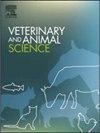不同哺乳母猪饲养策略的饲料消失、产量、皮肤损害和预测的环境后果
IF 1.9
Q2 AGRICULTURE, DAIRY & ANIMAL SCIENCE
引用次数: 0
摘要
高产母猪需要高采食量,以避免体重减轻和支持仔猪生长。我们比较了两个农场的三种哺乳喂养策略(n = 137头母猪)的生产措施、皮肤损伤和预测的环境结果。所有母猪根据泌乳期按饲料曲线饲喂。不同策略的喂食方式各不相同,要么限制在每日三次固定喂食时间(RESTR)分配;在同一时间只能获得相同的配额,但每个配额有两个小时的时间窗口(时段);或母猪从第6天开始连续获得每日分配量(ADLIB)的200%的饲料。槽和ADLIB母猪通过触发槽中的传感器获得饲料。数据采用线性混合模型进行分析。ADLIB策略母猪在泌乳期最后15 d的饲料消失量最高(FDL15D) (p = 0.01),代谢能覆盖率最高(p <;0.001)和预测的环境结果(N &;P分泌物;p & lt;0.001)。仔猪日增重、母猪减重、仔猪皮损和母猪肩损均无显著差异。虽然ADLIB的FDL15D最高,但饲喂量的增加可能发生在哺乳后期,对仔猪体重增加或母猪体重减轻没有任何影响。让母猪在饲养过程中有更多的选择,有望增加采食量,并可能有助于改善现有的饲养策略。然而,还需要进一步研究自由采食的长期影响和农场差异的重要性。本文章由计算机程序翻译,如有差异,请以英文原文为准。
Feed disappearance, production, skin lesions and predicted environmental outcomes from different lactating sow feeding strategies
Prolific sows require high feed intake to avoid weight loss and support piglet growth. We compared three lactational feeding strategies (n = 137 sows) on two farms on production measures, skin lesions and predicted environmental outcomes. All sows were fed from feed curves, based on the stage of lactation. Type of delivery varied across strategies, either restricted to the daily allotment at three fixed feeding times (RESTR); restricted to the same allotment at the same times but with a two-hour time window each (SLOTS); or sows had continual access to feed up to 200 % of their daily allotment (ADLIB) from day 6 on. SLOTS and ADLIB sows gained access to feed by triggering a sensor in the trough. Data were analysed using linear mixed models. Sows in the ADLIB strategy had the highest feed disappearance during the last 15 days of lactation (FDL15D) (p = 0.01), as well as highest coverage of metabolized energy (p < 0.001) and predicted environmental outcomes (N & P excretions; p < 0.001). No differences were seen for daily piglet mass gain, sow weight loss, piglet skin lesions and sow shoulder lesions. While the FDL15D of ADLIB was highest, the increase in feed allowance could have occurred too late in lactation to see any effects on piglet body mass gain or sow weight loss. Allowing sows more choice during feeding promises to increase feed intake and may help to improve existing feeding strategies. However, additional research is needed regarding long-term impact of ad-libitum feeding and the significance of farm differences.
求助全文
通过发布文献求助,成功后即可免费获取论文全文。
去求助
来源期刊

Veterinary and Animal Science
Veterinary-Veterinary (all)
CiteScore
3.50
自引率
0.00%
发文量
43
审稿时长
47 days
 求助内容:
求助内容: 应助结果提醒方式:
应助结果提醒方式:


